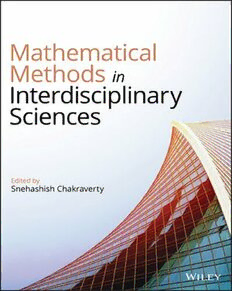Table Of Content(cid:2)
MathematicalMethodsinInterdisciplinarySciences
(cid:2) (cid:2)
(cid:2)
(cid:2)
Mathematical Methods in Interdisciplinary Sciences
Edited by
Snehashish Chakraverty
(cid:2) (cid:2)
(cid:2)
(cid:2)
Thiseditionfirstpublished2020
©2020JohnWiley&Sons,Inc.
Allrightsreserved.Nopartofthispublicationmaybereproduced,storedinaretrievalsystem,ortransmitted,inanyformorbyany
means,electronic,mechanical,photocopying,recordingorotherwise,exceptaspermittedbylaw.Adviceonhowtoobtainpermission
toreusematerialfromthistitleisavailableathttp://www.wiley.com/go/permissions.
TherightofSnehashishChakravertytobeidentifiedastheauthoroftheeditorialmaterialinthisworkhasbeenassertedin
accordancewithlaw.
RegisteredOffice
JohnWiley&Sons,Inc.,111RiverStreet,Hoboken,NJ07030,USA
EditorialOffice
111RiverStreet,Hoboken,NJ07030,USA
Fordetailsofourglobaleditorialoffices,customerservices,andmoreinformationaboutWileyproductsvisitusatwww.wiley.com.
Wileyalsopublishesitsbooksinavarietyofelectronicformatsandbyprint-on-demand.Somecontentthatappearsinstandardprint
versionsofthisbookmaynotbeavailableinotherformats.
LimitofLiability/DisclaimerofWarranty
Whilethepublisherandauthorshaveusedtheirbesteffortsinpreparingthiswork,theymakenorepresentationsorwarrantieswith
respecttotheaccuracyorcompletenessofthecontentsofthisworkandspecificallydisclaimallwarranties,includingwithout
limitationanyimpliedwarrantiesofmerchantabilityorfitnessforaparticularpurpose.Nowarrantymaybecreatedorextendedby
salesrepresentatives,writtensalesmaterialsorpromotionalstatementsforthiswork.Thefactthatanorganization,website,or
productisreferredtointhisworkasacitationand/orpotentialsourceoffurtherinformationdoesnotmeanthatthepublisherand
(cid:2) authorsendorsetheinformationorservicestheorganization,website,orproductmayprovideorrecommendationsitmaymake.This (cid:2)
workissoldwiththeunderstandingthatthepublisherisnotengagedinrenderingprofessionalservices.Theadviceandstrategies
containedhereinmaynotbesuitableforyoursituation.Youshouldconsultwithaspecialistwhereappropriate.Further,readers
shouldbeawarethatwebsiteslistedinthisworkmayhavechangedordisappearedbetweenwhenthisworkwaswrittenandwhenit
isread.Neitherthepublishernorauthorsshallbeliableforanylossofprofitoranyothercommercialdamages,includingbutnot
limitedtospecial,incidental,consequential,orotherdamages.
LibraryofCongressCataloging-in-PublicationData
Names:Chakraverty,Snehashish,editor.
Title:Mathematicalmethodsininterdisciplinarysciences/editedby
SnehashishChakraverty.
Description:Hoboken,NJ:Wiley,2020.|Includesbibliographical
referencesandindex.
Identifiers:LCCN2020001570(print)|LCCN2020001571(ebook)|ISBN
9781119585503(cloth)|ISBN9781119585619(adobepdf)|ISBN
9781119585657(epub)
Subjects:LCSH:Science–Mathematics.|Mathematicalanalysis.
Classification:LCCQ175.32.M38M382020(print)|LCCQ175.32.M38
(ebook)|DDC501/.51–dc23
LCrecordavailableathttps://lccn.loc.gov/2020001570
LCebookrecordavailableathttps://lccn.loc.gov/2020001571
CoverdesignbyWiley
Coverimage:©Sharlotta/Shutterstock
Setin9.5/12.5ptSTIXTwoTextbySPiGlobal,Chennai,India
PrintedintheUnitedStatesofAmerica
10 9 8 7 6 5 4 3 2 1
(cid:2)
(cid:2)
v
Contents
NotesonContributors xv
Preface xxv
Acknowledgments xxvii
1 ConnectionistLearningModelsforApplicationProblemsInvolvingDifferential
andIntegralEquations 1
SusmitaMall,SumitKumarJeswal,andSnehashishChakraverty
1.1 Introduction 1
1.1.1 ArtificialNeuralNetwork 1
1.1.2 TypesofNeuralNetworks 1
(cid:2) 1.1.3 LearninginNeuralNetwork 2 (cid:2)
1.1.4 ActivationFunction 2
1.1.4.1 SigmoidalFunction 3
1.1.5 AdvantagesofNeuralNetwork 3
1.1.6 FunctionalLinkArtificialNeuralNetwork(FLANN) 3
1.1.7 DifferentialEquations(DEs) 4
1.1.8 IntegralEquation 5
1.1.8.1 FredholmIntegralEquationofFirstKind 5
1.1.8.2 FredholmIntegralEquationofSecondKind 5
1.1.8.3 VolterraIntegralEquationofFirstKind 5
1.1.8.4 VolterraIntegralEquationofSecondKind 5
1.1.8.5 LinearFredholmIntegralEquationSystemofSecondKind 6
1.2 MethodologyforDifferentialEquations 6
1.2.1 FLANN-BasedGeneralFormulationofDifferentialEquations 6
1.2.1.1 Second-OrderInitialValueProblem 6
1.2.1.2 Second-OrderBoundaryValueProblem 7
1.2.2 ProposedLaguerreNeuralNetwork(LgNN)forDifferentialEquations 7
1.2.2.1 ArchitectureofSingle-LayerLgNNModel 7
1.2.2.2 TrainingAlgorithmofLaguerreNeuralNetwork(LgNN) 8
1.2.2.3 GradientComputationofLgNN 9
1.3 MethodologyforSolvingaSystemofFredholmIntegralEquationsofSecondKind 9
1.3.1 Algorithm 10
1.4 NumericalExamplesandDiscussion 11
1.4.1 DifferentialEquationsandApplications 11
1.4.2 IntegralEquations 16
1.5 Conclusion 20
References 20
(cid:2)
(cid:2)
vi Contents
2 DeepLearninginPopulationGenetics:PredictionandExplanationofSelection
ofaPopulation 23
RomilaGhoshandSatyakamaPaul
2.1 Introduction 23
2.2 LiteratureReview 23
2.3 DatasetDescription 25
2.3.1 SelectionandItsImportance 25
2.4 Objective 26
2.5 RelevantTheory,Results,andDiscussions 27
2.5.1 automl 27
2.5.2 HypertuningtheBestModel 28
2.6 Conclusion 30
References 30
3 ASurveyofClassificationTechniquesinSpeechEmotionRecognition 33
TanmoyRoy,TshilidziMarwala,andSnehashishChakraverty
3.1 Introduction 33
3.2 EmotionalSpeechDatabases 33
3.3 SERFeatures 34
3.4 ClassificationTechniques 35
3.4.1 HiddenMarkovModel 36
3.4.1.1 DifficultiesinUsingHMMforSER 37
(cid:2) 3.4.2 GaussianMixtureModel 37 (cid:2)
3.4.2.1 DifficultiesinUsingGMMforSER 38
3.4.3 SupportVectorMachine 38
3.4.3.1 DifficultieswithSVM 39
3.4.4 DeepLearning 39
3.4.4.1 DrawbacksofUsingDeepLearningforSER 41
3.5 DifficultiesinSERStudies 41
3.6 Conclusion 41
References 42
4 MathematicalMethodsinDeepLearning 49
SrinivasaManikantUpadhyayulaandKannanVenkataramanan
4.1 DeepLearningUsingNeuralNetworks 49
4.2 IntroductiontoNeuralNetworks 49
4.2.1 ArtificialNeuralNetwork(ANN) 50
4.2.1.1 ActivationFunction 52
4.2.1.2 LogisticSigmoidActivationFunction 52
4.2.1.3 tanhorHyperbolicTangentActivationFunction 53
4.2.1.4 ReLU(RectifiedLinearUnit)ActivationFunction 54
4.3 OtherActivationFunctions(VariantFormsofReLU) 55
4.3.1 SmoothReLU 55
4.3.2 NoisyReLU 55
4.3.3 LeakyReLU 55
4.3.4 ParametricReLU 56
4.3.5 TrainingandOptimizingaNeuralNetworkModel 56
(cid:2)
(cid:2)
Contents vii
4.4 BackpropagationAlgorithm 56
4.5 PerformanceandAccuracy 59
4.6 ResultsandObservation 59
References 61
5 MultimodalDataRepresentationandProcessingBasedonAlgebraicSystemof
Aggregates 63
YevgeniyaSulemaandEtienneKerre
5.1 Introduction 63
5.2 BasicStatementsofASA 64
5.3 OperationsonAggregatesandMulti-images 65
5.4 RelationsandDigitalIntervals 72
5.5 DataSynchronization 75
5.6 FuzzySynchronization 92
5.7 Conclusion 96
References 96
6 NonprobabilisticAnalysisofThermalandChemicalDiffusionProblemswithUncertain
BoundedParameters 99
SukantaNayak,TharasiDilleswarRao,andSnehashishChakraverty
6.1 Introduction 99
6.2 Preliminaries 99
(cid:2) 6.2.1 IntervalArithmetic 99 (cid:2)
6.2.2 FuzzyNumberandFuzzyArithmetic 100
6.2.3 ParametricRepresentationofFuzzyNumber 101
6.2.4 FiniteDifferenceSchemesforPDEs 102
6.3 FiniteElementFormulationforTaperedFin 102
6.4 RadonDiffusionandItsMechanism 105
6.5 RadonDiffusionMechanismwithTFNParameters 107
6.5.1 EFDMtoRadonDiffusionMechanismwithTFNParameters 108
6.6 Conclusion 112
References 112
7 ArbitraryOrderDifferentialEquationswithFuzzyParameters 115
TofighAllahviranlooandSoheilSalahshour
7.1 Introduction 115
7.2 Preliminaries 115
7.3 ArbitraryOrderIntegralandDerivativeforFuzzy-ValuedFunctions 116
7.4 GeneralizedFuzzyLaplaceTransformwithRespecttoAnotherFunction 118
References 122
8 FluidDynamicsProblemsinUncertainEnvironment 125
PerumandlaKarunakar,UddhabaBiswal,andSnehashishChakraverty
8.1 Introduction 125
8.2 Preliminaries 126
8.2.1 FuzzySet 126
8.2.2 FuzzyNumber 126
(cid:2)
(cid:2)
viii Contents
8.2.3 𝛿-Cut 127
8.2.4 ParametricApproach 127
8.3 ProblemFormulation 127
8.4 Methodology 129
8.4.1 HomotopyPerturbationMethod 129
8.4.2 HomotopyPerturbationTransformMethod 130
8.5 ApplicationofHPMandHPTM 131
8.5.1 ApplicationofHPMtoJeffery–HamelProblem 131
8.5.2 ApplicationofHPTMtoCoupledWhitham–Broer–KaupEquations 134
8.6 ResultsandDiscussion 136
8.7 Conclusion 142
References 142
9 FuzzyRoughSetTheory-BasedFeatureSelection:AReview 145
TanmoySom,ShivamShreevastava,AnoopKumarTiwari,andShivaniSingh
9.1 Introduction 145
9.2 Preliminaries 146
9.2.1 RoughSetTheory 146
9.2.1.1 RoughSet 146
9.2.1.2 RoughSet-BasedFeatureSelection 147
9.2.2 FuzzySetTheory 147
9.2.2.1 FuzzyToleranceRelation 148
9.2.2.2 FuzzyRoughSetTheory 149
(cid:2) (cid:2)
9.2.2.3 DegreeofDependency-BasedFuzzyRoughAttributeReduction 149
9.2.2.4 DiscernibilityMatrix-BasedFuzzyRoughAttributeReduction 149
9.3 FuzzyRoughSet-BasedAttributeReduction 149
9.3.1 DegreeofDependency-BasedApproaches 150
9.3.2 DiscernibilityMatrix-BasedApproaches 154
9.4 ApproachesforSemisupervisedandUnsupervisedDecisionSystems 154
9.5 DecisionSystemswithMissingValues 158
9.6 ApplicationsinClassification,RuleExtraction,andOtherApplicationAreas 158
9.7 LimitationsofFuzzyRoughSetTheory 159
9.8 Conclusion 160
References 160
10 UniversalIntervals:TowardsaDependency-AwareIntervalAlgebra 167
HendDawoodandYasserDawood
10.1 Introduction 167
10.2 TheNeedforIntervalComputations 169
10.3 OnSomeAlgebraicandLogicalFundamentals 170
10.4 ClassicalIntervalsandtheDependencyProblem 174
10.5 IntervalDependency:ALogicalTreatment 176
10.5.1 QuantificationDependenceandSkolemization 177
10.5.2 AFormalizationoftheNotionofIntervalDependency 179
10.6 IntervalEnclosuresUnderFunctionalDependence 184
10.7 ParametricIntervals:HowFarTheyCanGo 186
10.7.1 ParametricIntervalOperations:FromEndpointstoConvexSubsets 186
10.7.2 OntheStructureofParametricIntervals:AreTheyProperlyFounded? 188
(cid:2)
(cid:2)
Contents ix
10.8 UniversalIntervals:AnIntervalAlgebrawithaDependencyPredicate 192
10.8.1 UniversalIntervals,RationalFunctions,andPredicates 193
10.8.2 TheArithmeticofUniversalIntervals 196
10.9 TheS-FieldAlgebraofUniversalIntervals 201
10.10 GuaranteedBoundsorBestApproximationorBoth? 209
SupplementaryMaterials 210
Acknowledgments 211
References 211
11 Affine-ContractorApproachtoHandleNonlinearDynamicalProblemsinUncertain
Environment 215
NishaRaniMahato,SaudaminiRout,andSnehashishChakraverty
11.1 Introduction 215
11.2 ClassicalIntervalArithmetic 217
11.2.1 Intervals 217
11.2.2 SetOperationsofIntervalSystem 217
11.2.3 StandardIntervalComputations 218
11.2.4 AlgebraicPropertiesofInterval 219
11.3 IntervalDependencyProblem 219
11.4 AffineArithmetic 220
11.4.1 ConversionBetweenIntervalandAffineArithmetic 220
11.4.2 AffineOperations 221
(cid:2) 11.5 Contractor 223 (cid:2)
11.5.1 SIVIA 223
11.6 ProposedMethodology 225
11.7 NumericalExamples 230
11.7.1 NonlinearOscillators 230
11.7.1.1 UnforcedNonlinearDifferentialEquation 230
11.7.1.2 ForcedNonlinearDifferentialEquation 232
11.7.2 OtherDynamicProblem 233
11.7.2.1 NonhomogeneousLane–EmdenEquation 233
11.8 Conclusion 236
References 236
12 DynamicBehaviorofNanobeamUsingStrainGradientModel 239
SubratKumarJena,RajaramaMohanJena,andSnehashishChakraverty
12.1 Introduction 239
12.2 MathematicalFormulationoftheProposedModel 240
12.3 ReviewoftheDifferentialTransformMethod(DTM) 241
12.4 ApplicationofDTMonDynamicBehaviorAnalysis 242
12.5 NumericalResultsandDiscussion 244
12.5.1 ValidationandConvergence 244
12.5.2 EffectoftheSmall-ScaleParameter 245
12.5.3 EffectofLength-ScaleParameter 247
12.6 Conclusion 248
Acknowledgment 249
References 250
(cid:2)
(cid:2)
x Contents
13 StructuralStaticandVibrationProblems 253
M.AminChangiziandIonStiharu
13.1 Introduction 253
13.2 One-parameterGroups 254
13.3 InfinitesimalTransformation 254
13.4 CanonicalCoordinates 254
13.5 AlgorithmforLieSymmetryPoint 255
13.6 ReductionoftheOrderoftheODE 255
13.7 SolutionofFirst-OrderODEwithLieSymmetry 255
13.8 Identification 256
13.9 VibrationofaMicrocantileverBeamSubjectedtoUniformElectrostaticField 258
13.10 ContactFormfortheEquation 259
13.11 ReducingintheOrderoftheNonlinearODERepresentingtheVibrationofaMicrocantileverBeam
UnderElectrostaticField 260
13.12 NonlinearPull-inVoltage 261
13.13 NonlinearAnalysisofPull-inVoltageofTwinMicrocantileverBeams 266
13.14 NonlinearAnalysisofPull-inVoltageofTwinMicrocantileverBeamsofDifferentThicknesses 268
References 272
14 GeneralizedDifferentialandIntegralQuadrature:TheoryandApplications 273
FrancescoTornabeneandRossanaDimitri
14.1 Introduction 273
(cid:2) 14.2 DifferentialQuadrature 274 (cid:2)
14.2.1 GenesisoftheDifferentialQuadratureMethod 274
14.2.2 DifferentialQuadratureLaw 275
14.3 GeneralViewonDifferentialQuadrature 277
14.3.1 BasisFunctions 278
14.3.1.1 LagrangePolynomials 281
14.3.1.2 TrigonometricLagrangePolynomials 282
14.3.1.3 ClassicOrthogonalPolynomials 282
14.3.1.4 MonomialFunctions 291
14.3.1.5 ExponentialFunctions 291
14.3.1.6 BernsteinPolynomials 291
14.3.1.7 FourierFunctions 292
14.3.1.8 BesselPolynomials 292
14.3.1.9 BoubakerPolynomials 292
14.3.2 GridDistributions 293
14.3.2.1 CoordinateTransformation 293
14.3.2.2 𝛿-PointDistribution 293
14.3.2.3 StretchingFormulation 293
14.3.2.4 SeveralTypesofDiscretization 293
14.3.3 NumericalApplications:DifferentialQuadrature 297
14.4 GeneralizedIntegralQuadrature 310
14.4.1 GeneralizedTaylor-BasedIntegralQuadrature 312
14.4.2 ClassicIntegralQuadratureMethods 314
14.4.2.1 TrapezoidalRulewithUniformDiscretization 314
14.4.2.2 Simpson’sMethod(One-thirdRule)withUniformDiscretization 314
(cid:2)

